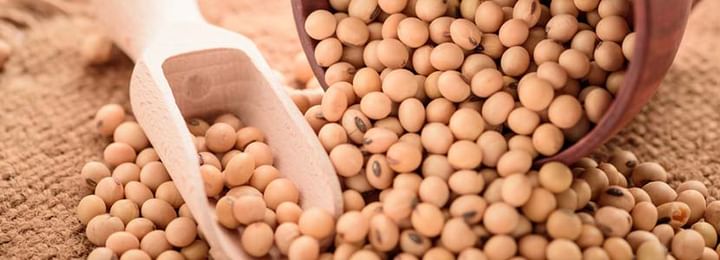Health Benefits Of Soybean, Uses And Its Side Effects
Last Updated: Feb 23, 2022
Health Benefits Of Soybean, Uses And Its Side Effects
Coming from a species of legumes, the Soya bean has numerous health benefits to offer. It is one of the most consumed foods in the world. It is the most important nutrient required in the body. Besides offering high-quality protein, it is super rich in saturated fats, antioxidants, Omega-3 fatty acids, fibre, and phytoestrogens.
There are various soy-based products available in the market and they have gained massive popularity due to high demand amongst the vegan population.
According to health experts, the Soya bean is extremely essential in maintaining a healthy lifestyle.
What are the nutritional value of the soya bean?
Soya bean is super high in protein. It also has a decent amount of fat and carbs that help in the proper functioning of the body. For all those who didn’t know, 100 grams of boiled soya bean offer:
- 9 grams of fat
- 16.6 grams of protein
- 9.9 grams of carbohydrates
- 173 calories
Proven Health Benefits Of Soybean
People have been using soya beans in their daily diet for ages. It is a highly nutritional food available especially for vegans. Here are some great health benefits of Soybean.
- Treats Sleep Disorders:
Many people may not be aware of this unusual health benefit of the soya bean. Soya bean has the potential of treating sleep disorder symptoms. People who have been suffering from insomnia should include soya beans in their daily diet.
The presence of a high amount of magnesium in soya beans is directly associated with improving the quality and duration of sleep.
- Manages Diabetes:
Do you know that eating soya beans regularly may help you in managing your diabetes? Well, thanks to its ability to produce insulin receptors! If you are already been suffering from diabetes, it manages your disease effectively and prevents further damages caused by the disease.
The quantity of carbohydrates in soya beans is very low. This is why health care experts often suggest people include this ideal food in their regular diet. Soya bean has anti-diabetic properties.
- Improves blood circulation:
According to recent studies, soya bean contains iron and copper which are vital components in generating red blood cells (RBCs). It improves blood circulation effectively.
Women suffering from the post-menopausal stage can opt for soya bean/ food cooked using soya bean. It helps in managing the symptoms and makes the body super-efficient in performing almost every task.
- Essential for pregnancy:
Soya bean is a great source of folic acid and vitamin B complexes. These components are very important for women who are in their pregnancy stage. Experts suggest that iron and vitamin B is essential for the development of the fetus.
Many women who don’t take care of their nutritional requirements tend to give birth to babies with birth defects. Hence, make sure you take a sufficient amount of soya beans during pregnancy.
- Have anti-cancerous properties:
The presence of antioxidants in the soya bean makes it an ideal food that can prevent several types of cancers. It works by removing the free radicals from the body and killing the cells that are responsible for cancer development.
Soya beans produce healthy cells in the body. People already suffering from cancer can include soya beans in their diet as it can reduce the after-effects of the treatments.
There are ample benefits that soya bean can offer. The only thing that you need to look after is- it should be a part of your diet in a planned manner. It not only ensures your overall well-being, but also prevents you from dangerous diseases like diabetes, cancer, and birth defects.
Nutritional facts Per 100 Grams in Soybeans
Vitamins and Minerals in Soybeans
Uses of Soybean
Soybean's clean, natural taste and nearly imperceptible odour support and enhance the natural flavours of prepared foods. Soybean's neutral flavour lets the real taste of the food product come through. Adaptable to nearly every fat or application in the food industry, soybean works well with other ingredients including other fats and oils, making it very suitable for use in salad dressings, sauces and baked goods.
Soybean is available with AOM (active oxygen method) stability levels ranging from 15 to over 300 hours, and it is a proven performer in the wide range of applications required by snack food manufacturers, bakeries, food service providers and more. Liquid soybean is used in 100% formulations for cooking oil and to create mayonnaise, salad dressings and sauces.
Soybean can turn two ounces of olive oil into a whole pint of flavoured for dressings. The distinctive olive oil aroma will be evident, even though the bulk of the dressing's component comes from inexpensive soybean. Compared to other vegetable oils, soybean has a good emulsifying ability, making it the first choice of the general food industry.
Side-Effects & Allergies of Soybean
Soybean is safe for most adults when taken by mouth in amounts normally found in food and when applied to the skin as an insect repellent in recommended amounts. Pharmaceutical quality soybean is also safe when used as a nutritional supplement in intravenous feedings.
The processed soybean (unsaponifiable fractions of soybean) has been used safely in research studies for up to 6 months. However, a few side effects of Soybean include allergies in persons who are hypersensitive to Soybean and other Soy-products, problems like gynecomastia, changes in the mood, and obesity which is more pronounced in men due to an increase in estrogen levels.
Soybean and other Soy-products have a number of minerals and components, which can have various side effects on the human body, but most of these minerals, are prone to lose their effects when exposed to heat or cooking.
Cultivation of Soybean
Unlike the seeds of most other legumes (except the peanut), the soybean is rich in oil and is often called an 'oil seed'. The great majority of the world's soybeans are processed by the soybean crushing industry to produce crude soy (also called 'crude soybean') and soybean meal.
The is then degummed (to remove the lecithin) and usually refined, bleached, partially hydrogenated, and deodorized to make a variety of popular products, such as salad and cooking oils, shortenings, and margarine.
Since its first appearance in the 11th century AD, the Chinese term for 'soy' has been written with the two characters meaning 'bean' and 'oil'. The Chinese term for the press cake that remains after the expression of soybeans, a term which first appeared during the 1400s, is written with the characters meaning 'bean' and 'cake' or 'soybean' and cake.'
In the United States, the earliest terminology for soy followed the Chinese pattern. It was called 'Chinese bean' by Roelofsen (1894) and 'bean' by Carson (1909) and many other early writers well into the 1920s (Piper and Morse 1923; South Manchuria Railway Co. 1926).
Other popular terms in the early 1900s were 'soya bean' ( New York, Paint, and Drug Reporter 1910 Ref??; Toch 1912; New York Times 1916), 'soybean' (Thompson and Morgan 1912; Bailey and Reuter 1919), and 'soybean' (Williams 1916a, b; Holmes 1918).
The modern term 'soy' was first used by Jordan in 1918, but it was not widely used until the 1940s. From the early 1920s until the present the term 'soybean' (first introduced by Piper and Morse in 1923) was the one most widely used. However, in 1944 Pellett of the American Soybean Association ASA) recommended that this term be changed to the shorter soy, which also avoided the use of the word 'bean'.
This change was slow to catch on, however, until the ASA began intensive market development and promotion for soy in the late 1970s and early 1980s, and actively stressed the benefits of the shorter term.
Yet even in 1982, this oil is usually referred to in most scholarly publications and on most food product labels as 'soybean'. The term 'soy', however, will probably become the standard eventually. Or will it be 'soy', and even shorter-term that began to appear here and there in the late 1970s (Thompson 1978; Soybean Update, 26 July 1982).
References
- Mateos-Aparicio I, Redondo Cuenca A, Villanueva-Suárez MJ, Zapata-Revilla MA. Soybean, a promising health source. Nutricion hospitalaria. 2008;23(4). [Cited 26 June 2019]. Available from:
- Omoni AO, Aluko RE. Soybean foods and their benefits: potential mechanisms of action. Nutrition reviews. 2005 Aug 1;63(8):272-83. [Cited 26 June 2019]. Available from:
- Dixit AK, Antony JI, Sharma NK, Tiwari RK. 12. Soybean constituents and their functional benefits [Interent] 2011: 367-383. [Cited 26 June 2019]. Available from:
Table of content
Ask a free question
Get FREE multiple opinions from Doctors



